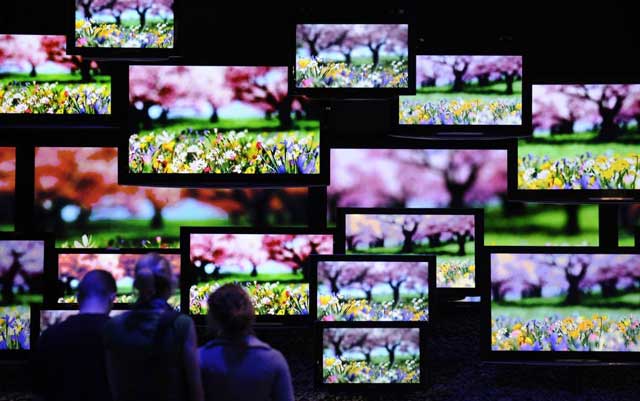Giant plasma TVs face ban in battle to green Britain
New rules will phase out energy-guzzling flatscreen televisions as the EU brings its climate campaign to the living room

Your support helps us to tell the story
From reproductive rights to climate change to Big Tech, The Independent is on the ground when the story is developing. Whether it's investigating the financials of Elon Musk's pro-Trump PAC or producing our latest documentary, 'The A Word', which shines a light on the American women fighting for reproductive rights, we know how important it is to parse out the facts from the messaging.
At such a critical moment in US history, we need reporters on the ground. Your donation allows us to keep sending journalists to speak to both sides of the story.
The Independent is trusted by Americans across the entire political spectrum. And unlike many other quality news outlets, we choose not to lock Americans out of our reporting and analysis with paywalls. We believe quality journalism should be available to everyone, paid for by those who can afford it.
Your support makes all the difference.Energy-guzzling flatscreen plasma televisions will soon be banned as part of the battle against climate change, ministers have told The Independent on Sunday.
"Minimum energy performance standards" for televisions are expected to be agreed across Europe this spring, they say, and this should lead to "phasing out the most inefficient TVs". At the same time, a compulsory labelling system will be drawn up to identify the best and worst devices.
The moves, which follow last week's withdrawal of the 100W incandescent lightbulb, are part of a drive to slow the rapid growth of electricity consumption in homes by phasing out wasteful devices and introducing more efficient ones. Giant plasma televisions – dubbed "the 4x4s of the living room" – can consume four times as much energy as traditional TVs that used cathode ray tubes (CRTs).
Over the past 30 years, the number of electric appliances and gadgets in a typical home has almost trebled – from 17 to 47 – as a host of devices from scanners to security systems, cappuccino makers to computer game consoles have joined the more traditional kettles, irons, vacuum cleaners and cookers. And the number of televisions in homes has also grown rapidly; there are now 60 million of them, one for every person in the country.
The amount of power needed to run this electronic explosion has more than doubled in the same period, and the official Energy Savings Trust estimates that it will grow by another 12 per cent over the next four years.
The boom in flatscreen TVs, partly spurred by the digital changeover, is helping to fuel the increase, as is the growing size of the screens. The Department for Environment, Food and Rural Affairs (Defra) said last week: "In the past five years we have seen the main television in a household change from typically being a 24in to 32in CRT television to being a much larger flatscreen television, with screen sizes of between 32 and 42 inches becoming more and more common. Not surprisingly, this has seen the energy used by the main television in the house increase."
Different makes and models of television vary in their use of power, but a 42in plasma television may use some 822 kilowatt hours a year, compared to 350kWh by an LCD flat screen of the same size. A 32in CRT, the biggest available, would use 322kWh.
Power consumption goes up as the screens increase in size, so the trust says that a big plasma model could use four times as much electricity and be responsible for the emission of four times as much carbon dioxide as the biggest CRT; they now account for twice as much as a fridge-freezer.
Now European governments are finalising a mandatory EU regulation to set minimum standards for televisions. The worst performers will be phased out, and the rest will have to be labelled with energy ratings which, says Defra, "will make it easier for consumers to identify the most and least energy-efficient televisions available". The scheme is modelled on an existing one for fridges and other white goods which has greatly increased their efficiency over the past decade.
The EU has already agreed minimum standards for the electricity consumed in standby mode. Defra says this should cause a fourfold drop by early next year in the energy used by a TV when it has been switched off by remote control instead of the main switch. Similar steps are being taken in Australia and the United States; in the US, 275 million televisions gobble up as much electricity as is produced by 10 coal-fired power stations.
Manufacturers are responding by making their products greener. The best new plasma televisions now use one-third less energy than the average, and new LED televisions, which are more efficient, are being developed.
Join our commenting forum
Join thought-provoking conversations, follow other Independent readers and see their replies
Comments